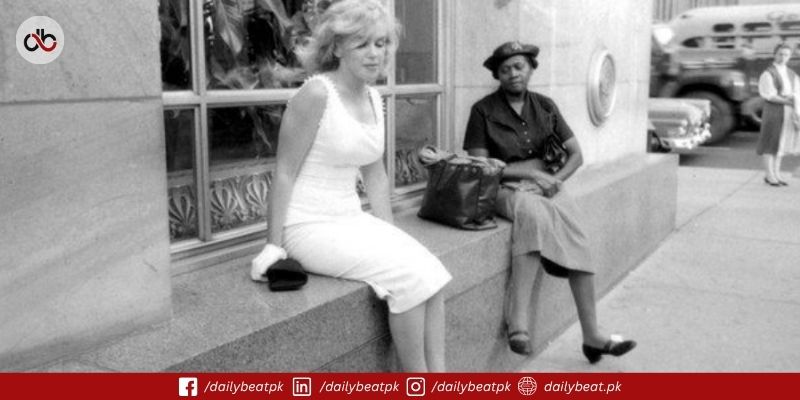Marilyn Monroe didn’t just wear beautiful clothes. She wore power. She turned fashion into her armor in a world that often tried to control her. Her style wasn’t just glamorous. It was strategic. Marilyn Monroe challenged the Hollywood machine through every dress, pose, and public appearance. She used her image to take control of her story and outshine the system built to contain her.
This blog explores how Marilyn Monroe transformed clothing into an influence. It examines how she challenged norms, shifted public narratives, and used style to craft her legacy. More than just a starlet, Marilyn Monroe was a master of image-making.
The Power Behind the Glamour
In the golden age of Hollywood, studios owned everything. They shaped stars, wrote public statements, and decided what they wore. But Marilyn Monroe fought for her image. She understood that her look could command headlines, magazine covers, and public fascination.
Her fashion wasn’t just about being beautiful. It was about being unforgettable. The media often reduced her to a “blonde bombshell,” but Marilyn Monroe leaned into the stereotype on her terms. She chose clothes that magnified her allure and exaggerated her presence. Behind every silk gown and red lipstick was a woman who knew exactly what she was doing.
Working with Designers Who Understood Her Vision
One of the most significant influences on Marilyn Monroe’s fashion was her collaboration with designer William Travilla. He created some of her iconic costumes, including the unforgettable white halter dress from The Seven Year Itch.
Travilla helped her shape a visual identity far beyond script or character. These weren’t just costumes. They were calculated statements. Monroe used her wardrobe to claim space in a male-dominated industry. She wasn’t just playing roles. She was setting trends and demanding attention.
Monroe also worked with Jean Louis, the designer behind her skin-tight, sparkling gown, while singing “Happy Birthday” to President John F. Kennedy. That dress looked nearly invisible, covered in hand-sewn crystals. The moment was bold and controversial, but achieved exactly what she intended. It made her the center of every conversation.
Iconic Fashion Moments That Made a Statement
The White Halter Dress
This dress became one of the most famous outfits in film history. It flowed, shimmered, and danced around her legs as she stood over a subway grate. But more than being attractive, it symbolized her control over the male gaze. She didn’t hide from it—she owned it. That moment became a cultural event, one that outlasted the film itself.
The Pink Satin Gown
In Gentlemen Prefer Blondes, Marilyn wore a stunning pink gown with long gloves and sparkling diamonds. This look became a fashion moment copied across generations. Madonna replicated it in her “Material Girl” video. Celebrities continue to reference it. Monroe knew how to blend costume, confidence, and charm into a moment that would live forever.
The Birthday Dress
When Marilyn sang for JFK in 1962, she wore a dress that blurred the line between elegance and scandal. It was bold, nearly transparent, and covered in over 2,500 rhinestones. She had it sewn onto her body. The press couldn’t stop talking about it. Once again, Monroe controlled the narrative using fashion, not words.
Using Fashion to Fight the System
Marilyn Monroe often felt trapped by the roles Hollywood gave her. Dumb blonde. Fragile beauty. But she turned those labels into tools. Her fashion created a version of herself stronger than any contract or criticism.
Outside of her on-screen persona, Monroe often dressed in surprisingly modest, simple outfits. She wore jeans, turtlenecks, and ballet flats. She looked relaxed and thoughtful. These moments showed fans the “real” Marilyn: intelligent, sensitive, and grounded. That balance made her seem more human and more powerful.
She wasn’t just playing to expectations. She was flipping them. She blurred the lines between costume and identity, carefully constructing a media persona that defied easy categories.
Media Persona and Public Control
Marilyn Monroe’s fashion wasn’t about following trends. It was about starting them. She understood how to grab attention. She knew what would appear on front pages. She used color, cut, and fabric to send messages. In a time when women were often told to stay quiet, she made herself impossible to ignore.
Her fashion choices shaped not only how she was seen but how she would be remembered. She didn’t just fit into Hollywood glamour—she became its symbol. Her name is still tied to elegance, confidence, and sensuality today.
Modern celebrities and influencers continue to echo her looks. Her impact lives on in red carpets, fashion editorials, and popular culture. She became an icon using fabric, heels, and red lipstick. That’s not accidental. That’s strategy.
Lasting Legacy of a Fashion Revolutionary
Marilyn Monroe’s fashion wasn’t just for show. It was a language. Through it, she spoke about freedom, desire, and control. She challenged the Hollywood system, not by fighting it directly, but by becoming more powerful than it.
Each dress she wore became a message: I decide who I am. I define my worth. I control my image.
She broke barriers and reshaped how the world viewed femininity. She showed that being glamorous doesn’t mean being passive. She made fashion into a form of rebellion. That is why her style still inspires artists, designers, and performers today.
Her legacy teaches us that power doesn’t always roar. Sometimes, it walks quietly in heels and silk, smiling in front of flashing cameras, fully aware of what it’s doing.
Final Thoughts
Marilyn Monroe used style to do what few dared: she turned the system on itself. She didn’t have the power of a studio executive or director. But she had the power of image. She crafted it with care, with collaboration, and with intention. Every look she wore told the world she was more than a role, more than a symbol, and far more than a stereotype.
Her clothes weren’t just fashion. They were statements. And through them, she built a legend that outlasted the machine that tried to control her.















